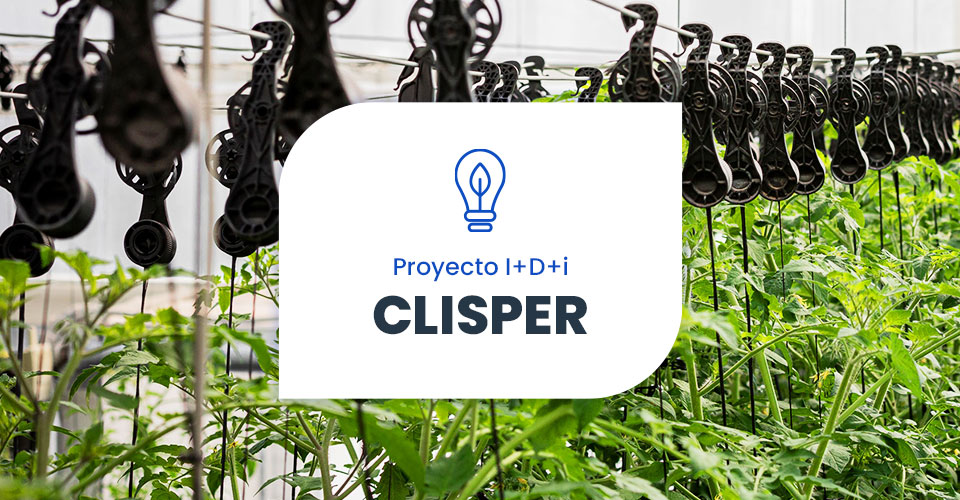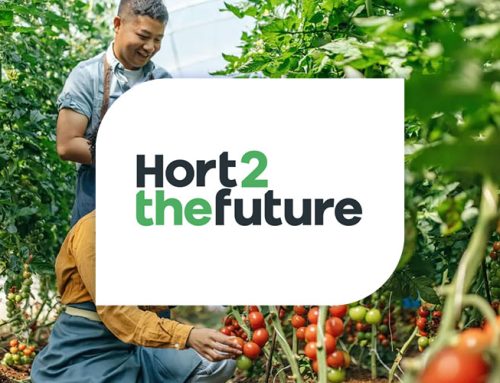CLISPER. Perches for crop training
Design of a trellising system using hangers to support the plant stem in greenhouses.
Innovation project “Hanger Clisper Tomato and winder”.
In tomato cultivation, the planting frame is established according to the size of the plant, which in turn depends on the commercial variety grown. Thus, the planting density is usually around 2 plants/m2.
Once the planting density has been determined, a pruning strategy is established, which is an essential practice for vegetables with indeterminate growth.
This cultural work is carried out 15-20 days after transplanting with the appearance of the first lateral stems, which will be removed, as well as the oldest leaves, with the aim of achieving a vegetative structure of the plant that favors production and also improves the aeration of the neck of the plant. The number of arms (stems) to be left per plant will also be determined. Pruning to 1 or 2 branches is frequent..
The stems or arms of the tomato plant are not kept upright, so in order to keep them vertically, and thus take advantage of the radiation and facilitate cultural work, the technique of trellising is applied, which will facilitate the quality and quantity of fruit, and better control of diseases.
This technique consists of holding the stem of the plant by means of a thread or string that is usually made of raffia (polypropylene or similar), so that one end of the thread is located in the basal part of the plant (held by clips) and the other end is attached to a horizontal wire mesh located inside the greenhouse (“grating”) at a variable height from the ground depending on the type of greenhouse, by means of a CLISPER hanger.
Once the plant has reached the “trellis”, with the classic systems, it is guided to hang down the wire towards the ground, which causes a hypertrophy of the stem that prevents the normal circulation of the sap flow, resulting in production losses.
Another possibility is that the plant grows horizontally on the wires of the trellis, which causes an excess of vegetation, lack of light, a focus of pests and diseases, as well as a decrease in quality.
Therefore, one or the other cultural practice does not ensure the growth of the plant in a way that guarantees the correct formation of the plant and the fruits.
The best option in these cases is to lower the plant by unhooking the thread, for which “hangers” are used, which have enough thread wound on them to unhook the plant during the whole growing cycle.
In this way the plant always develops upwards, receiving the maximum amount of light, which improves the quality of the fruit and increases production, since we can lengthen the growing cycle.
Partners
- Novagric (Novedades Agrícolas, S.A.)
- University of Almeria
- Center for Technological Innovation of the Junta de Andalucía (Andalusian Regional Government)
Financing
Project financed with CDTI fundsCategorías
Últimas novedades
- This Christmas, agriculture takes shape at Novagric
- HORT2THEFUTURE. Oxygen irrigation to improve soils
- HORT2THEFUTURE. Oxygen irrigation to improve soils
- GREENFOLD. Foldable and Reusable Greenhouses
- DARkWIN. Project to improve crops in the face of climate change
- +PreVENT. Positive pressure system for ecological greenhouses
- Novagric develops Solidarity Agricultural Projects
- Carbon Fertilisation Levels in Greenhouses
- How to control the climate during carbon fertilisation
- i-GROW. Protected crop management support systemtivos protegidos






